

Virtual Private Cloud (VPC) – Secure Private Cloud VPN. Product Details. The Domain Name System (DNS) is a globally distributed service that is foundational to the way people use the Internet.
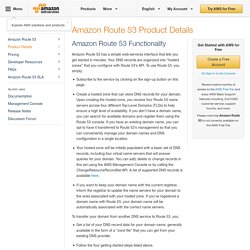
DNS uses a hierarchical name structure, and different levels in the hierarchy are each separated with a dot ( . ). Consider the domain names www.amazon.com and aws.amazon.com. In both these examples, “com” is the Top-Level Domain and “amazon” the Second-Level Domain. There can be any number of lower levels (e.g., “www” and “aws”) below the Second-Level Domain. Computers use the DNS hierarchy to translate human readable names like www.amazon.com into the IP addresses like 192.0.2.1 that computers use to connect to one another.
Route 53 is an “authoritative DNS” system. The name for our service (Route 53) comes from the fact that DNS servers respond to queries on port 53 and provide answers that route end users to your applications on the Internet. Route 53 provides a simple set of APIs that make it easy to create and manage DNS records for your domains. Product Details. Architecture Center. The AWS Architecture Center is designed to provide you with the necessary guidance and best practices to build highly scalable and reliable applications in the AWS Cloud.
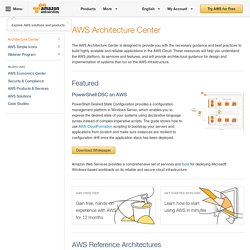
These resources will help you understand the AWS platform, its services and features, and will provide architectural guidance for design and implementation of systems that run on the AWS infrastructure. Amazon Web Services provides a comprehensive set of services and tools for deploying Microsoft Windows-based workloads on its reliable and secure cloud infrastructure. The flexibility of AWS allows you to design your application architectures the way you like.
AWS Reference Architecture Datasheets provide you with the architectural guidance you need in order to build an application that takes full advantage of the AWS cloud. Each datasheet includes a visual representation of the architecture and basic description of how each service is used. 10 comparisons between Google Apps and Office 365. Google Apps and Office 365 are the leading contenders in the cloud-based business application space.
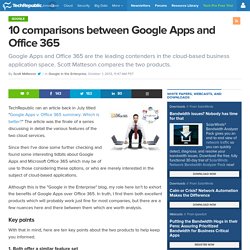
Scott Matteson compares the two products. TechRepublic ran an article back in July titled "Google Apps v. Office 365 summary: Which is better? " The article was the finale of a series discussing in detail the various features of the two cloud services. Since then I've done some further checking and found some interesting tidbits about Google Apps and Microsoft Office 365 which may be of use to those considering these options, or who are merely interested in the subject of cloud-based applications. Although this is the "Google in the Enterprise" blog, my role here isn't to exhort the benefits of Google Apps over Office 365. Key points With that in mind, here are ten key points about the two products to help keep you informed. Google Apps for Work – Email, Calendars, Video Calls, Storage & Docs.
Google app engine or amazon web services. 24 Cloud Storage Solutions for Small Businesses. Cloud storage can save your business.
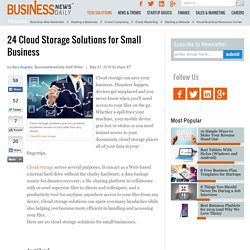
Disasters happen, devices get misplaced and you never know when you'll need access to your files on the go. Whether a spill fries your machine, your mobile device gets lost or stolen or you need instant access to your documents, cloud storage places all of your data at your fingertips. Cloud storage serves several purposes. It can act as a Web-based external hard drive without the clunky hardware; a data backup source for disaster recovery; a file-sharing platform to collaborate with or send supersize files to clients and colleagues; and a productivity tool for anytime, anywhere access to your files from any device. Gartner’s cloud showdown: Amazon Web Services vs. Microsoft Azure. Gartner IaaS Research Director Kyle Hilgendorf says one of the most common questions he gets from enterprise customers looking to go to the cloud is: AWS or Azure?
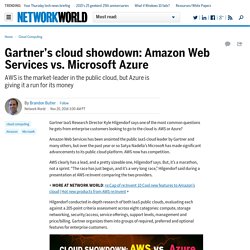
Amazon Web Services has been anointed the public IaaS cloud leader by Gartner and many others, but over the past year or so Satya Nadella’s Microsoft has made significant advancements to its public cloud platform. AWS now has competition. AWS clearly has a lead, and a pretty sizeable one, Hilgendorf says. But, it’s a marathon, not a sprint: “The race has just begun, and it’s a very long race,” Hilgendorf said during a presentation at AWS re:Invent comparing the two providers. + MORE AT NETWORK WORLD: re:Cap of re:Invent 10 Cool new features to Amazon’s cloud | Hot new products from AWS re:Invent + Of the features that Gartner believes are required for enterprise use cases, AWS has 92% of them covered; Azure has 75%.
Google Cloud Computing, Hosting Services & Cloud Support — Google Cloud Platform. Pricing. How Azure Pricing Works. Microsoft Azure allows you to quickly deploy infrastructures and services to meet all of your business needs.

You can run Windows and Linux based applications in 19 Azure datacenter regions, delivered with enterprise grade SLAs. Sign-up and start a free trial today. Please call us at 1-800-867-1389 if you have any questions about Azure pricing or capabilities that you’d like answered. Pricing details Estimate your expected monthly bill using our Pricing Calculator, and track your actual account usage and bill at any time using the billing portal. Flexible Purchase Options Azure is available for purchase in 141 countries around the world, and we support billing in 24 currencies.